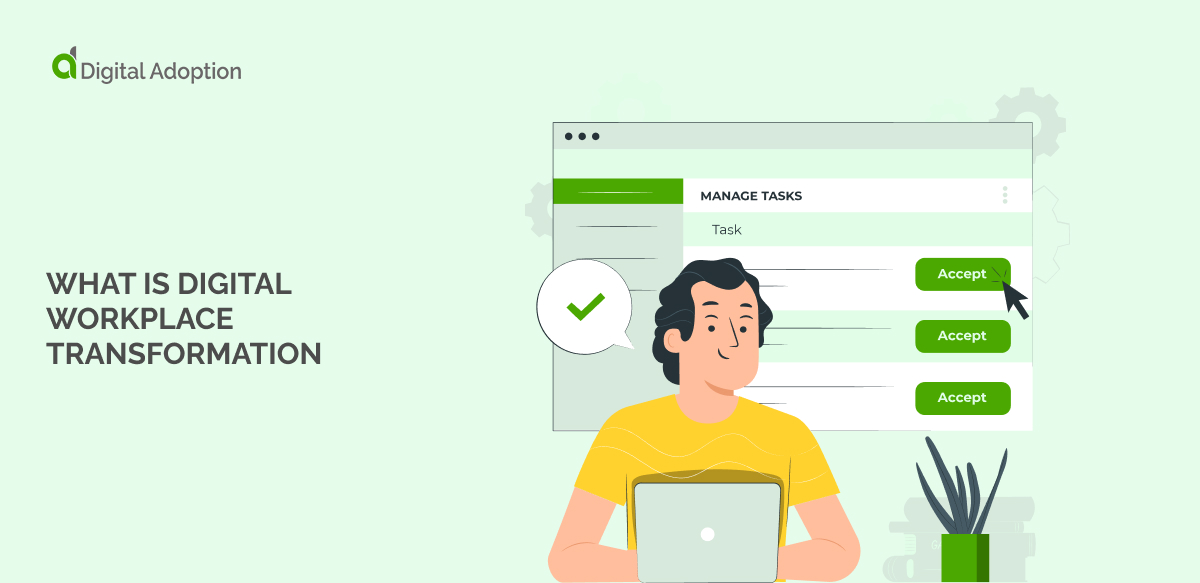Digital transformation at the workplace refers to:
- The change in how organizations operate due to advancements in digital technology.
- The change in how employees interact with each other because of these technological advancements.
- Companies’ investments in new technologies with aims to:
- Improve workplace efficiency
- Increase collaboration among employees
- Streamline organizational processes.
As a result of these changes and investments, there has been a rapid transformation in the digital landscape of workplaces.
Statista reports that in 2022, the global workplace transformation market has already reached an impressive 19 billion U.S. dollars in value, and analysts predict that by 2030, this sector will rise to 70 billion U.S. dollars or more. This is thanks to digital technologies, such as cloud computing, revolutionizing our work.
These latest technologies include cloud computing, artificial intelligence, big data analytics, mobile device management, robotic process automation, serverless computing, and virtual reality. Each of these technologies offers unique benefits that can help organizations reach their goals for digital transformation.
- Why Is Digital Workplace Transformation Important?
- The Advantages of Digital Workplace Transformation
- The Challenges of Digital Workplace Transformation
- How to Create a Productive Digital Workplace
- The Impact of COVID-19 on Digital Workplace Transformation
- Keys to Sustaining Long-term Success with Digital Workplace Transformation
- Understanding Technology Acceptance and Adoption Toward Digital Transformation
Why Is Digital Workplace Transformation Important?
Digital workplace transformation helps streamline processes, increase collaboration, mitigate risk, and transform customer relationships.
It also enables a greater understanding of the needs of employees and customers, allowing organizations to respond quickly to any changes in market conditions or customer preferences by introducing new processes or launching new products faster.
At its core, digital workplace transformation creates an environment where people can work together with greater trust and transparency. These changes help businesses keep pace with the changing technological landscape and prepare for the future by creating an agile organization ready to succeed no matter what comes their way.
Reaffirming the increasing ubiquity of innovative tech within the workplace, The IDC predicts that By 2023, 60% of G2000 Businesses Will Deploy AI- and ML-Enabled Platforms to support the entire employee life-cycle experience from onboarding through retirement.
The Advantages of Digital Workplace Transformation
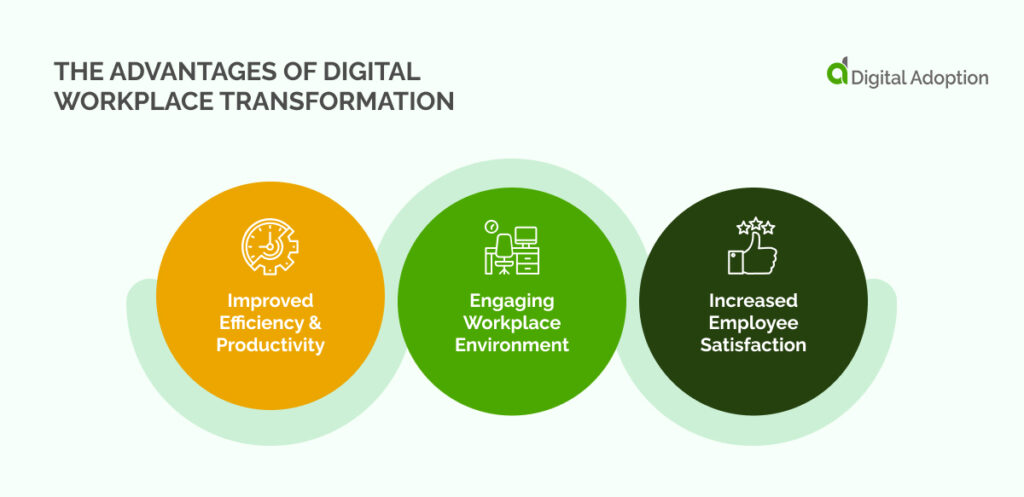
The Advantages of Workplace Transformation
The modern workspace is ever-evolving. With time, the needs and demands for productivity, efficiency, and worker satisfaction are growing. One of the best ways to meet these demands is to undergo workplace transformation.
Businesses can achieve greater success by making changes that prioritize employees, developing new tools to streamline processes, or even introducing flexible working environments.
Here are some of the advantages of workplace transformation:
1) Improved Efficiency & Productivity – Businesses can increase their efficiency and productivity by improving team dynamics, introducing new technologies, and creating better working conditions through workplace transformation measures.
2) Engaging Workplace Environment – Through workplace transformation, businesses can create an engaging and positive atmosphere that increases morale and fosters creativity. This increases employee loyalty as they feel more valued in their work environment.
3) Increased Employee Satisfaction – Businesses can increase employee satisfaction over time by adjusting workspaces with ergonomic furniture, instituting flexible hours/working arrangements, and introducing more opportunities for collaboration with workplace transformation initiatives. This leads to improved retention rates, higher job performance outcomes, and a healthier bottom line.
The Challenges of Digital Workplace Transformation
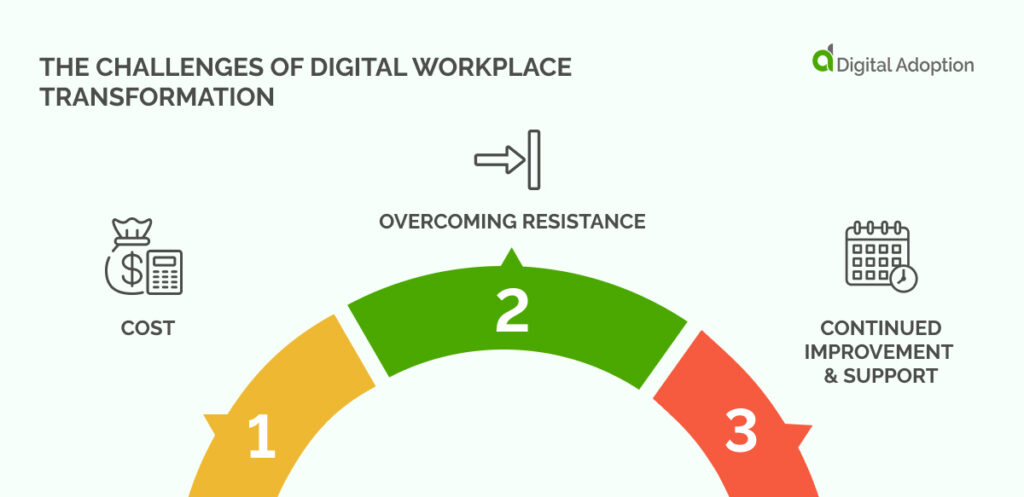
The concept of workplace transformation may sound great in theory, but it can take time to implement successfully in practice. There are several key challenges that businesses must face when transforming their workplaces.
1) Cost – Implementing workplace transformation initiatives can come with a hefty price tag regarding the physical costs associated with making changes and the financial resources needed to make those changes happen.
2) Overcoming Resistance – Even if businesses have the resources and funding to implement workplace transformation initiatives, there may be resistance from workers who are hesitant to embrace change. Employers must consider this when introducing new practices and policies, providing ample time for workers to become accustomed and comfortable with any changes.
3) Continued Improvement & Support – Successful workplace transformation requires continual effort and support after implementation. This includes regularly evaluating processes’ functioning, monitoring team dynamics, and offering ongoing training opportunities or support services for any new tools or systems the business introduces.
How to Create a Productive Digital Workplace
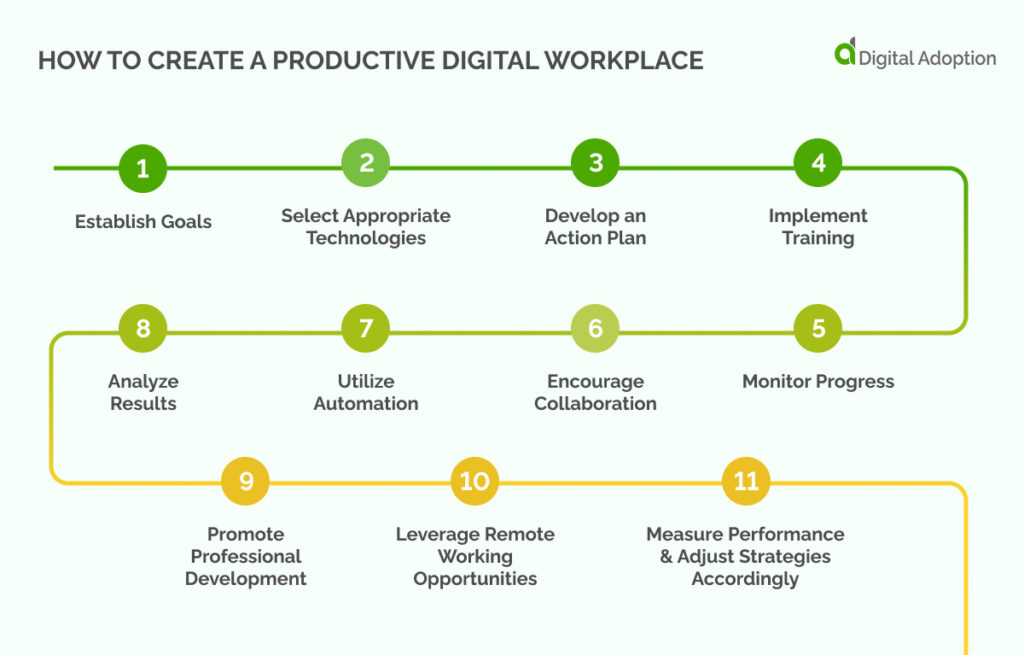
Creating a productive digital workplace doesn’t have to be complicated. By following these twelve strategic steps, businesses can ensure employees remain engaged and motivated in their roles:
- Establish Goals
- Select Appropriate Technologies
- Develop an Action Plan
- Implement Training
- Monitor Progress
- Encourage Collaboration
- Utilize Automation
- Analyze Results
- Promote Professional Development
- Leverage Remote Working Opportunities
- Measure Performance & Adjust Strategies Accordingly
The Impact of COVID-19 on Digital Workplace Transformation
The COVID-19 pandemic has had far reaching effects across the world, and is no exception to its impact on technology. In recent years, businesses have had to adapt to survive during these unprecedented times. One such adaptation is digital transformation — the process of using technology to solve organizational problems.
The global pandemic forced organizations to rapidly adopt digital tools in order to cope with a sharp reduction in business operations while maintaining customer engagement and satisfaction. As digital transformation was already a priority before the crisis, it became even more important during the pandemic allowing organizations to stay competitive despite the obstacles they may face.
One of the most immediate impacts of COVID-19 on digital transformation has been an increase in digital adaptation as businesses looked for new ways to operate safely and efficiently. With remote work becoming much more prevalent due to social distancing and other health guidelines, companies turned to technologies like cloud computing and virtual collaboration platforms such as Zoom and Microsoft Teams in order to stay connected with their employees.
In addition, companies have also embraced mobile solutions like mobile apps for customers looking for quick information and services from their favorite brands or stores. This shift towards mobile platforms not only drives customer engagement but also provides significant cost savings for businesses looking for long-term efficiency gains.
It’s clear that technology will continue to be an integral part of our lives post-pandemic, particularly when it comes to workplace operations. Businesses that fail to invest in the right tools may find themselves lagging behind competitors who are actively leveraging emerging technologies such as IoT, automation or blockchain solutions. However, there is still time for businesses of all types and sizes to join in this revolution before we arrive at what is now a radically different business landscape post-COVID 19.
Keys to Sustaining Long-term Success with Digital Workplace Transformation
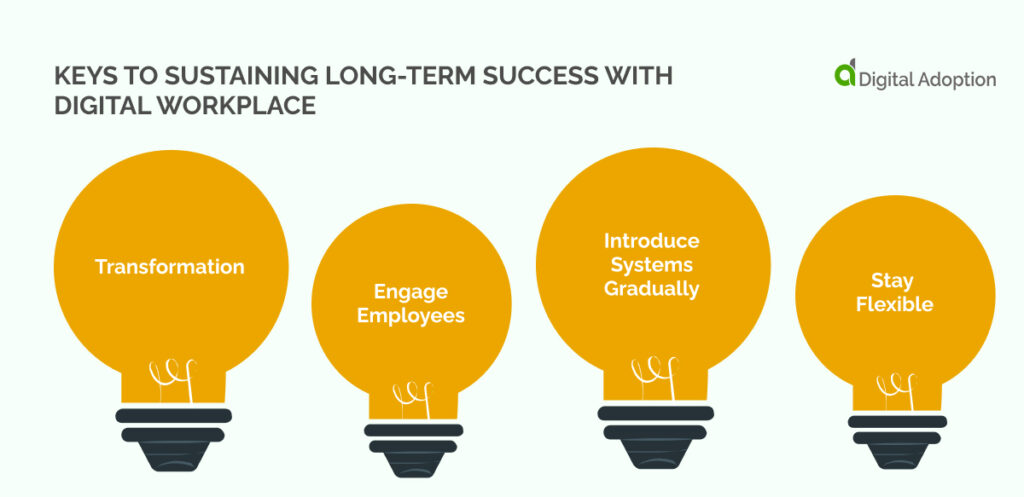
Digital workplace transformation is an ongoing process that requires continual effort and attention to achieve long-term success. Here are some key tips businesses should consider as they embark on their journey:
1) Engage Employees – Involving employees in the transformation process is important, as they will use the implemented tools and systems. Providing training opportunities or inviting feedback from team members can help ensure everyone feels comfortable using new technologies and actively embraces change.
2) Introduce Systems Gradually – Don’t try to implement a full suite of digital solutions all at once; instead, take your time and introduce them individually. This allows you to adapt each system accordingly to work best for your business.
3) Stay Flexible – The digital landscape constantly changes, so businesses must stay agile. This means regularly evaluating how technologies function, monitoring team dynamics and ensuring any processes introduced remain effective over time.
Understanding Technology Acceptance and Adoption Toward Digital Transformation
Much has been said about the effect of attitudes on behavioral intention regarding technology usage. Attitudes toward technology are important in understanding how people will behave when using it.
Generally speaking, positive attitudes towards technology will likely result in a higher intention and motivation to use it, while negative attitudes may lead to resistance or avoidance. Research has also identified that individuals with more knowledge and experience in using a particular technology tend to have more positive attitudes, which can result in better usage outcomes.
Digital workplace transformation is a complex yet important process that can benefit employers and employees. It involves understanding the utilization of innovative technologies and techniques to create meaningful change in current working practices.
Though it may not be easy, by carefully analyzing their current workflows, businesses can more easily implement changes that will optimize their performance, resulting in improved employee engagement, morale, and satisfaction.
According to Forrester’s research, customer-centric technology will be a key factor in promoting competition and productivity; this tech is expected to help increase efficiency by 3-5%.
Despite popular belief, digital workplace transformations are for more than just large organizations with global teams, they are also for tech-savvy companies. Digital workplace transformations can benefit organizations of all sizes and sectors. Ultimately, digital workplace transformation requires understanding the potential positive impact on productivity and organizational culture.
.

